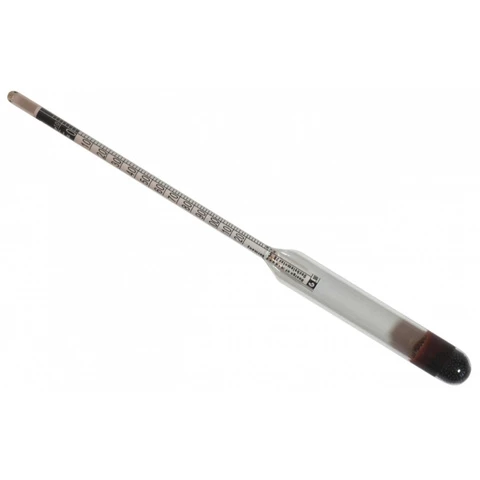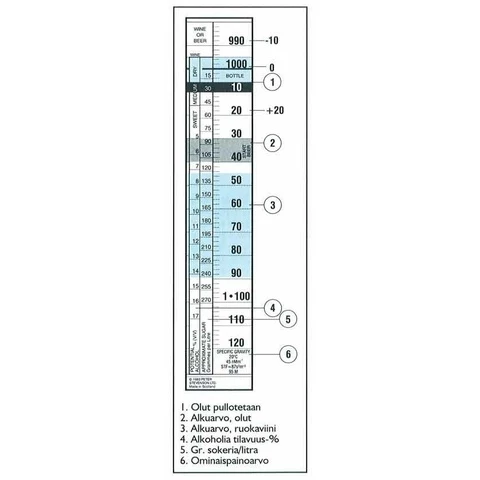Specific gravity meter Instructions for the specific gravity meter Use of the specific gravity meter The floating specific gravity meter is used to measure the density (specific gravity) of a liquid, which in the context of wine and beer production practically means the sugar content of the wine liquid / beer wort. The scale of the meter used for this purpose is the so-called Oechsle scale (pronounced Öksle). The starting point is the specific gravity of water at 20ºC 1000g/liter, which is marked on the scale either as 1.000 or 0, depending on the manufacturer. The scale usually varies between 1.130 (130) and 0.985 (-15), which is 15 Oechsle degrees below the specific gravity of water (1.000). Sugar being heavier than water increases the specific gravity, while alcohol being lighter than water lowers it. 25 grams of sugar per 10 liters of liquid increases the specific gravity value by one degree. The specific gravity meter is used by placing it freely floating in the liquid to be measured. The easiest way to measure is in a tall enough transparent container, e.g. a measuring glass. The meter must therefore float freely, and it must not hit the edges of the measuring vessel. After the movement of the meter stops, the reading of the scale is read from the level of the liquid surface. The higher the reading, the more sugar there is in the liquid, and vice versa. Estimating the amount of sugar needed Example: We want to make 20 liters of wine with an alcohol content of 14% by volume. The main raw material of the wine is 5 liters of strong berry juice. 17 grams of sugar in a liter of water gives 1% alcohol by volume as a result of fermentation. So 20 liters of 14% wine requires a total of 4760 grams of sugar. Calculation to get the result: 20 (liter) x 17 (g sugar/liter) x 14 (alcohol % ) = 4760 grams. Berry juice contains the berries' own sugar and sugar added during juicing, but how much? It can be found by measuring the specific gravity of the juice. If the meter shows a reading of 1.060 (+60), the juice contains 150 grams of sugar/liter of juice. The total amount of juice therefore contains 750 g of sugar (5 liters x 150 grams = 750 g). When this amount is subtracted from the total amount of sugar, the amount of additional sugar needed is approx. 4 kg (4760 g – 750 g = 4010 g). With this amount of sugar, you get a wine with an alcohol content (when fermented dry) of 14% by volume. Note! The specific gravity value when fermenting the wine should be no more than 1.120 (120) so that the fermentation of the wine does not deteriorate. Calculating the alcohol content of the finished wine How much sugar has there been in the wine overall, and how much is left after fermentation has stopped? When you know how much sugar has been consumed during fermentation, you can calculate the alcohol content of the wine. Example: The raw materials of the wine are estimated to contain approx. 400 grams of fermentable sugar, including raisins. 6 kg of sugar has been added. Excluding the amount of wine liquid, the volume taken by the solid material is 20 liters. There is thus a total of 6.4 kg of sugar, or 320 g/liter of liquid. For some reason, the fermentation of the wine has stopped at a specific gravity reading of 1.015 (+15). If the wine had gone dry, the specific gravity reading would have dropped another 20 degrees to 0.995 (-5). The difference between the desired dry-fermented and actual specific gravity value is therefore 20, which corresponds to approx. 50 g of unfermented sugar per liter. So 270 g of sugar has been consumed per liter of wine (320 g – 50 g = 270 g). Since 17 g of sugar/liter of liquid produces alcohol equal to one percent by volume, this wine contains approx. 16 percent alcohol by volume (270 : 17 = 15.9). Calculating the other way around: a drop of 7.5 degrees on the scale of the specific gravity meter increases the alcohol content of the wine by one percent by volume. When the initial specific gravity value of the wine has been measured, the alcohol content can be calculated from the difference between the initial and final values by dividing it by 7.5. If the difference is e.g. 80, the alcohol content of the wine is 10.7% by volume (80 : 7.5 = 10.7). In the example case, the calculation would be roughly as follows: 120 : 7.5 = 16.

